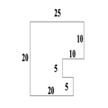
The beginning exercise or assignment for a brand new student
- Subject:
- Engineering
- Material Type:
- Activity/Lab
- Author:
- Tom Sanford
- Date Added:
- 01/30/2024

The beginning exercise or assignment for a brand new student

This is a short description of the ACAT Method.The method uses analogous comparisons by taking examples or situations from everyday life and in consequence the logical or analogous transfer to the scientific problem. The method uses the development of imaginations or “pictures in the head” to develop a view of the analogy; this picture is transferred as a problem-solving idea to the concrete scientific problem. Multimedia material like animations are used to provide a higher level of imagination and to develop the understanding for the discussed problem.
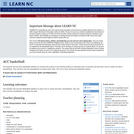
The students will use ACC basketball statistics to practice the process of converting fractions to decimals then to percents and will learn how to create and edit a spreadsheet. They will then use this spreadsheet to analyze their data. This unit is done during the basketball season which takes approximately 15 weeks from the middle of November to the middle of March. Teachers must have Clarisworks to open the sample spreadsheet in the lesson, but may recreate it in another spreadsheet program.
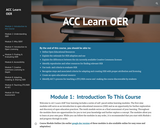
Austin Community College (ACC) Learn OER includes a series of self-paced online learning modules. The first nine modules will serve as an introduction to open educational resources (OER) and as an opportunity for further exploration and discovery of open education practices. The tenth module serves as a final assessment of your learning. Throughout the modules there are opportunities for you to test your knowledge and further explore a concept. The modules allow you to learn at your own pace. While you can follow the modules in any order, it is recommended that you start with Module 1 and progress through in order.
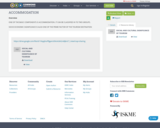
ONE OF THE BASIC COMPONENTS IS ACCOMMODATION. iT CAN BE CLASSIFIED IN TO TWO GROUPS.SOCIO ECONOMIC SIGNIFICANCE IS ALSO ONE OF THE PRIME FACTOR OF THE TOURISM DESTINATION

A course originally designed as competency-based courses and as such, they include specific language related to CBE style instruction and they are organized by competency so some terminology changes and course restructuring may be required in order to fit well into a quarterly schedule.
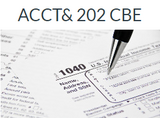
Principles of Accounting II is a course from a competency-based business degree pilot. You must be logged into your institutional Canvas account to access this shell.
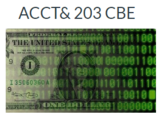
Principles of Accounting III is a course from a competency-based business degree pilot. You must be logged into your institutional Canvas account to access this shell.
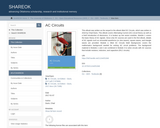
This eBook was written as the sequel to the eBook titled DC Circuits, which was written in 2016 by Chad Davis.
This eBook covers Alternating Current (AC) circuit theory as well us a brief introduction of electronics. It is
broken up into seven modules. Module 1 covers the basic theory of AC signals. Since only DC sources are used in
the first eBook, details of AC signals such as sinusoidal waveforms (or sine waves), square waves, and triangle
waves are provided. Module 2, titled AC Circuits Math Background, covers the mathematics background needed
for solving AC circuit problems. The background material in Modules 1 and 2 are combined in Module 3 to solve
circuits with AC sources that include resistors, inductors, and capacitors (RLC circuits).
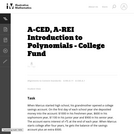
This is a task from the Illustrative Mathematics website that is one part of a complete illustration of the standard to which it is aligned. Each task has at least one solution and some commentary that addresses important asects of the task and its potential use. Here are the first few lines of the commentary for this task: When Marcus started high school, his grandmother opened a college savings account. On the first day of each school year she deposited money into the ac...
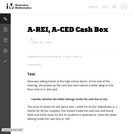
The given solutions for this task involve the creation and solving of a system of two equations and two unknowns, with the caveat that the context of the problem implies that we are interested only in non-negative integer solutions. Indeed, in the first solution, we must also restrict our attention to the case that one of the variables is further even.
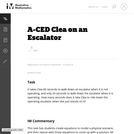
This is a task from the Illustrative Mathematics website that is one part of a complete illustration of the standard to which it is aligned. Each task has at least one solution and some commentary that addresses important asects of the task and its potential use. Here are the first few lines of the commentary for this task: It takes Clea 60 seconds to walk down an escalator when it is not operating, and only 24 seconds to walk down the escalator when it is operating. How m...

This is a task from the Illustrative Mathematics website that is one part of a complete illustration of the standard to which it is aligned. Each task has at least one solution and some commentary that addresses important asects of the task and its potential use. Here are the first few lines of the commentary for this task: Sara's doctor tells her she needs between 400 and 800 milligrams of folate per day, with part coming from her diet and part coming from a multi-vitamin...
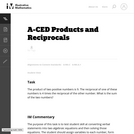
This is a task from the Illustrative Mathematics website that is one part of a complete illustration of the standard to which it is aligned. Each task has at least one solution and some commentary that addresses important asects of the task and its potential use. Here are the first few lines of the commentary for this task: The product of two positive numbers is 9. The reciprocal of one of these numbers is 4 times the reciprocal of the other number. What is the sum of the ...
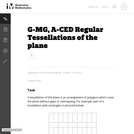
This task examines the ways in which the plane can be covered by regular polygons in a very strict arrangement called a regular tessellation. These tessellations are studied here using algebra, which enters the picture via the formula for the measure of the interior angles of a regular polygon (which should therefore be introduced or reviewed before beginning the task). The goal of the task is to use algebra in order to understand which tessellations of the plane with regular polygons are possible.

This is a task from the Illustrative Mathematics website that is one part of a complete illustration of the standard to which it is aligned. Each task has at least one solution and some commentary that addresses important asects of the task and its potential use. Here are the first few lines of the commentary for this task: In each of the equations below, rewrite the equation, solving for the indicated variable If $F$ denotes a temperature in degrees Fahrenheit and $C$ is ...
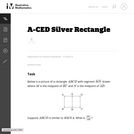
This is a task from the Illustrative Mathematics website that is one part of a complete illustration of the standard to which it is aligned. Each task has at least one solution and some commentary that addresses important asects of the task and its potential use. Here are the first few lines of the commentary for this task: Below is a picture of a rectangle $ABCD$ with segment $\overline{MN}$ drawn where $M$ is the midpoint of $\overline{BC}$ and $N$ is the midpoint of $\o...
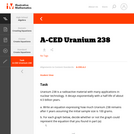
This is a task from the Illustrative Mathematics website that is one part of a complete illustration of the standard to which it is aligned. Each task has at least one solution and some commentary that addresses important aspects of the task and its potential use.
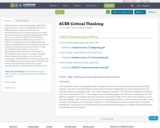
ACES (Academic, Career & Employability Skills) The goal of ACES is to ensure that Adult Basic Education (ABE) programs are able to provide effective contextualized instruction integrating post-secondary education and training readiness, employability skills, and career readiness at all levels. The Transitions Integration Framework (TIF) is the cornerstone of ACES. It was designed to provide ABE programs and instructors with guidance on the effective integration of transitions skills into instruction at all levels of ABE. The TIF defines the academic, career, and employability skills essential for adult learners to successfully transition to post-secondary education, career training, the workplace, and community involvement. The ACES Resource Library contains tools to help ABE practitioners incorporate the TIF skills into lessons and instructional settings and provides materials that can be used directly with adult learners.

ACES (Academic, Career & Employability Skills)
The goal of ACES is to ensure that Adult Basic Education (ABE) programs are able to provide effective contextualized instruction integrating post-secondary education and training readiness, employability skills, and career readiness at all levels.
The Transitions Integration Framework (TIF) is the cornerstone of ACES. It was designed to provide ABE programs and instructors with guidance on the effective integration of transitions skills into instruction at all levels of ABE. The TIF defines the academic, career, and employability skills essential for adult learners to successfully transition to post-secondary education, career training, the workplace, and community involvement.
The ACES Resource Library contains tools to help ABE practitioners incorporate the TIF skills into lessons and instructional settings and provides materials that can be used directly with adult learners.